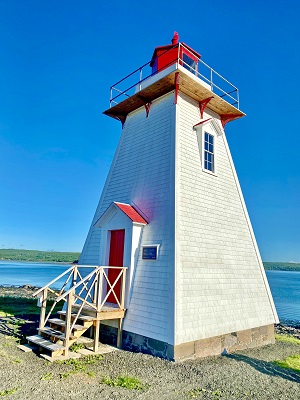Schafner Point Lighthouse
Heritage Lighthouse
County of Annapolis, Nova Scotia

General View
(© Randy Swigart - Port Royal Lighthouse Association, 2024 IMG_300)
Address :
Granville Road, Schafter Point, County of Annapolis, Nova Scotia
Recognition Statute:
Heritage Lighthouse Protection Act (S.C. 2008, c 16)
Designation Date:
2015-02-12
Dates:
-
1885 to 1885
(Construction)
-
1885 to 1885
(Established)
Other Name(s):
-
Port Royal Ligthouse
(Other Name)
Description of Historic Place
The Schafner Point Lighthouse is a 13 metres (43 feet) square-tapered, wooden tower surmounted by a superimposed gallery and a red octagonal iron lantern. Constructed in 1885, it is the first lighthouse on the site but the second navigational aid erected on the Digby Gut–Annapolis Basin water corridor. It is located 11 km downstream from Annapolis Royal on the north side of the Annapolis Basin.
Heritage Value
The Schafner Point Lighthouse is a heritage lighthouse because of its historical, architectural, and community values.
Historical values
The Schafner Point Lighthouse is an excellent example of the theme of improving aids to navigation along the Digby Gut–Annapolis Basin water corridor. Built in 1885, it is the oldest surviving lighthouse in the Annapolis Basin. It continues to warn mariners of the turbulent tidal waters of the narrow navigation channel.
The Schafner Point Lighthouse is an excellent example of the socio-economic development of Digby Gut. It played a key role in the development of the fishing and trade industries of the Annapolis Basin. With the growing maritime traffic along the Digby Gut–Annapolis Basin waterway, the lighthouse provided better navigational safety in the narrow and offset channel around Goat Island.
Architectural values
The Schafner Point Lighthouse is a simple but handsome and well-executed example of a tower with a superimposed gallery. It characterizes an economical approach to tower construction that is lighter and less robust than a tower with a structurallyintegrated gallery. The picturesque octagonal iron lantern with its metal weathervane ventilator illustrates the typical 19th century industrial design used by the Department of Marine and Fisheries.
Built using standard construction technology and materials of its time, the Schafner Point Lighthouse presents no technological innovations, but does represent well in the choice and use of materials and in the execution of its compact and efficient design. The lighthouse has withstood more than a century of exposure to Atlantic Canada’s weather, a tribute to its materials, craftsmanship, and ongoing maintenance.
Community values
Located on a small rise on the north side of the Annapolis Basin facing Goat Island, the Schafner Point Lighthouse reinforces the maritime character of the area. It is a physically impressive sight from the flat expanse of the Annapolis Basin shore.
Known locally as the Port Royal lighthouse, the Schafner Point Lighthouse is highly valued in the County of Annapolis as an important heritage and tourism asset. The County takes pride in promoting and protecting its rich cultural heritage.
Related buildings
No related buildings are included in the designation.
Character-Defining Elements
The following character-defining elements of the Schafner Point Lighthouse should be respected:
— its location on a small rise on the north side of the Annapolis Basin facing Goat Island;
— its intact, as-built structural form, height, profile and balanced proportions, based on the standard design of square-tapered wooden towers;
— its square, wooden structure with tapered shingled sides rising from the concrete foundation base;
— its superimposed square, wooden gallery supported by curved iron brackets;
— its plain metal railing that surrounds the gallery;
— its octagonal iron lantern with its metal weathervane ventilator;
— its raised entry door and eight paned windows which project vertically from the tower’s sloping walls and are crowned with simple pediments;
— its traditional red and white exterior colour scheme consisting of a white tower and gallery, accented by red features such as the lantern, the trim of the door and windows pediments, and the gallery brackets;
— its visual prominence in relation to the water and landscape.